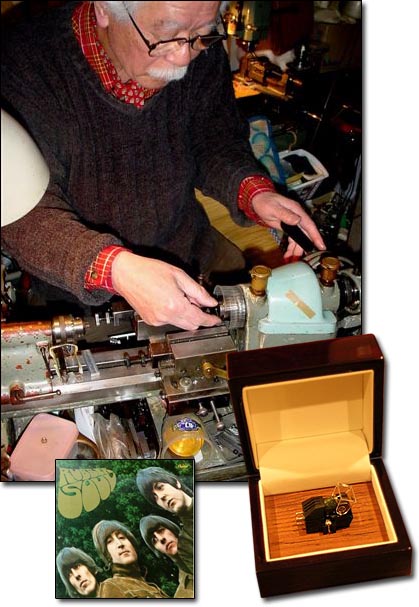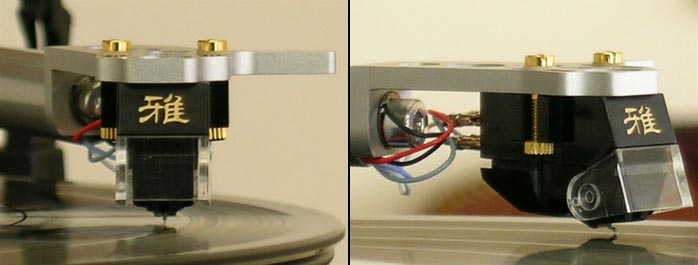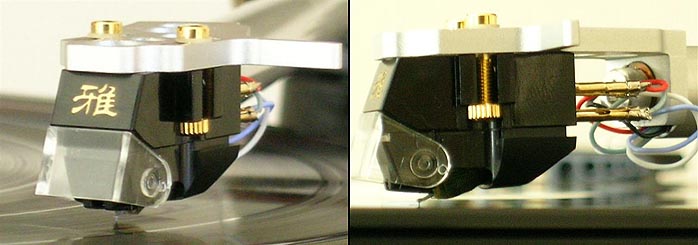|
This review page is supported in part by the sponsor whose ad is displayed above
|
|||||||||||
 |
|||||||||||
 |
|||||||||||
 |
|||||||||||
Reviewer: Jeff Day Vinyl: Garrard 301, Cain & Cain plinth, Denon 103 MC cartridge, Pete Riggle Audio VTAF, Fi Yph phono stage, Auditorium 23 moving coil step-up transformer, Origin Live Silver Mk 1 and Mk 2 tonearms; Miyabi 47 MC cartridge [on review], Miyabi Standard MC cartridge [this review], SME 3012 tonearm, Tom Evans Audio Design Groove+ phono stage, The Cartridge Man Isolator [in for review] FM source: Vintage early 1960s Scott 370 FM vacuum tube tuner, Magnum Dynalab ST-2 vertical omnidirectional FM antenna Digital sources: Meridian 508.20 CD player, Audio Logic 2400 DAC, Superscope PSD340 Music Practice Tool & CD recording system Preamplifiers: Tom Evans Audio Design Lithos 7 Vibe with optional Pulse power supply Integrated amplifiers: Almarro A205A Mk1 & Mk2, Sonic Impact Class T, Sonic Impact Super T Amplifiers: Fi 2A3 monoblocks; Tom Evans Audio Design Linear A Speakers: Avantgarde Duo 2.1, Omega Super 3 (Skylan Stands); Omega Super 3 XRS [in for review] Cables: 47 Laboratory OTA cable kit; Nirvana S-L & S-X interconnects, S-L speaker cables, Duo wiring harness, and Transmission Digital Interface; Cardas Neutral Reference digital cable, Auditorium 23 speaker cable; Tom Evans Audio Design interconnects. Stands: McKinnon Bellevue Symphony media cabinet, Atlantis Video Reference equipment rack, Billy Bags 2-shelf rack Room size: 20' L x 17' W x 17' H Review component retail: $3,950 |
|||||||||||
 |
|||||||||||
Master Takeda San Master Takeda San is an independent designer who crafts ultra-performance moving coil (MC) phonograph cartridges under his own brand name of Miyabi and for other high-performance audio companies that have included the likes of Krell, Cello and Mark Levinson. I profiled Takeda San in my review of the Miyabi Standard MC cartridge in June 2006 and I refer you to that article to get a more complete history of his accomplishments as a designer and cartridge craftsman. Miyabi, the namesake of Takeda San's phonograph cartridges, is a Japanese value that can only be crudely translated into English. The concept of miyabi arose in the Japanese medieval period when artists, writers, poets and intellectuals became concerned over the flood of ignorance and barbarism entering into and diluting their culture. In response, they cultivated and elevated their unique Japanese values of beauty, nobility and enlightenment at the heart of their culture. Miyabi was one of those values. It was connected with appreciating a moment of transitory and refined beauty as it passes before you in time. Appreciating the blooming then fading beauty of flowers in Spring; the colorful then falling leaves of Autumn; and the musicality of the analogue LP during the transition to a digital season are all examples of miyabi. Master Takeda San embodies the value of miyabi with each of the MC phonograph cartridges that he crafts to provide the music lover a glimpse into the transitory beauty of music that only the vinyl LP makes so readily accessible. We are perhaps in vinyl's November now, with digital winds whistling a cacophonous melody of vinyl's imminent demise. Miyabi phonograph cartridges are Takeda San's gift to those of us who want the maximum listening enjoyment of vinyl's beauty to remain with us for just a little longer. |
|||||||||||
| Design Philosophy Takeda San was frustrated by the lack of communication of the music to the listener via a HiFi compared to that of a live concert. Upon meditation, he believed that the major factor responsible for lack of communication was the lack of a smoothly flowing linearity in dynamics from the lowest pianissimo to the highest fortissimo. He noticed when listening to recordings that even beautiful performances become unenjoyable and diminished in scale and impact when modulations in dynamics didn't track those of the live musical event. A piano fortissimo reduced to a mezzo forte doesn't convey the emotive intention of the artist. It destroys the intended excitement by the passion of the playing being reduced from a boil to a simmer. |
|||||||||||
 |
|||||||||||
| Takeda San realized that the design of most cartridges did not allow for the accurate gradations of dynamics to be expressed properly. For over 30 years, he labored to perfect his cartridge design so that it would express the dynamics of live music from a recording properly. He found that the materials that cartridges were made out of had a big influence on this quality and he carefully chooses the various materials that go into his Miyabi cartridges with this in mind. After Master Takeda San finishes crafting each Miyabi cartridge, he listens to it for a couple of hours and fine-tunes its performance. Then he lets it sit for a week and repeats the listening and fine-tuning process. He goes through this process 10 or more times until he is completely satisfied that the cartridge performance has reached a stable stage of excellence. This fine-tuning process takes | |||||||||||
| Takeda San 2 - 3 months from the time he constructs a Miyabi cartridge to its delivery. He says, "a Miyabi cartridge is like a living thing made of a combination of different materials. It needs to be well taken care of to reach its stable stage in the same way that a baby needs care and a child needs an education to grow up to become a decent adult." Miyabi 47 Takeda San's main design goal for the Miyabi 47 was to improve the dynamic range compared to the Miyabi Standard while maintaining its excellent dynamic linearity. The materials used to construct the internals of the Miyabi 47 are similar to those used in the Standard - copper coils, Alnico magnets and an aluminum alloy cantilever, except that they are implemented very differently. The body material is completely different, with the Standard made of aluminum, the Miyabi 47 of polymer. The Miyabi 47 cartridge has an output voltage of 0.3 mV and a frequency response of 20Hz - 40kHz (± 2dB). The channel separation is greater than 25dB and the internal impedance is 2 ohms. The Miyabi 47 is a low compliance cartridge at 8.5 x 10 (-6) cm/dyne and has a recommend tracking force of 2 grams. The stylus is a line contact design and the cantilever is a special aluminum alloy. The magnet material is Alnico and the coils are copper. The weight of the cartridge is 8.5 grams. |
|||||||||||
 |
|||||||||||
Listening impressions The first few moments of listening to music with new HiFi gear -- before your mind kicks in and begins analyzing -- can tell you a lot. It's in those first few moments when your subconscious reacts very simply to the music with a gut feeling of "I like it!" or "I don't like it!" response. Those first gut feelings to the subliminal cues of how well the equipment is playing music to suit your tastes may very well determine your long-term satisfaction with a new piece of gear. Once your mind starts analyzing performance, it's easy to be led down that dark path of intellectually bullshitting about what you really like. "Listen to that soundstaging and 3-D imaging!" "Wow! What incredible detail recovery!" "What amazing bass response!" This is something that HiFi salesmen exploit when trying to describe equipment to potential clients, with the effect of moving you away from the realm of feelings which ultimately will determine your long-term satisfaction with a piece of gear. Of course that's with the caveat that you're listening to equipment that has stabilized in performance during the break-in process. When friends Stephæn and Pete stopped by for a little HiFi fun'n'games, I cued up an album using the Miyabi 47 cartridge. Stephæn's response after the music played for a few moments was, "that's the best I've heard your system sound". Pete echoed Stephæn's sentiments. Both responses occurred in the first few moments of listening to the Miyabi 47 playing the tunes. I think that's noteworthy. A primary reviewing challenge is to be able to translate those first impressions (and later ones too) into words that articulate both what you are hearing and what you are feeling when listening to music through the review gear. My process often goes like this: Getting first impressions, trying to understand how what I heard made me feel about the music, and then trying to articulate it in words in an interesting and meaningful fashion to readers. That's harder to do well than it sounds. Break-in issues aside, I've found over time that my first impressions are usually an accurate representation of how well I will like something over the long haul. |
|||||||||||
 |
|||||||||||
| Like Stephæn and Pete, my immediate response to the Miyabi 47 was "I like it!" It felt good to listen to music with the Miyabi 47 in the mix. With the cartridge passing the first test of a positive initial reaction, now comes the tougher part of describing what I heard and why I liked what it was doing with the music. That is, unless you'd settle for the three word review of "I like it!". Well, I didn't think so. I cued up the Classic Records remaster of the Mercury Living Presence Balalaika Favorites with the Osipov state Russian folk orchestra - one of my all-time favorite classical discs. The overall character of the Miyabi 47 is just to the warm side of neutral but it doesn't sacrifice transparency to achieve that warmth. Transparency is quite spectacular. Timbre is right on. Tone is exceptional and deeply hued. Images have a lot of body. There's plenty of detail revealed with natural texture. The detail is not at all etched, rather being more rounded, organic and natural which is quite a feat. There is a lot of dynamic gradation even in the nuance of notes in the pianissimo range, with very fine shifts all the way up through forte swings. The agility across the range of micro to macro dynamics is particularly impressive. The reproduction of musical tempi is spot-on, with even subtle speed variations easily evident. The rhythmic prowess of the Miyabi 47 is perfection itself. The width of the soundstage is huge, extending well beyond the edges of my Duos. The depth of the soundstage is very deep and continuous, with much layering in evidence. Imaging is spectacular. The music feels very life-like and my attention is continually drawn to what is happening musically - although the sound is very spectacular when I think about it. It isn't the least bit fatiguing or distracting. I could feel my body relax while still being stimulated by the music as I listened, a sure sign of musical enjoyment. I really couldn't find anything at all to fault about the Miyabi 47 while listening to Balalaika. It was simply wonderful in the way it portrayed the music. The Miyabi 47 is a cartridge that really has it all: it plays music remarkably well and sonically is spectacular. I predict the Miyabi 47 will appeal to both music lovers and sound buffs equally. On the Classic Records remaster of the single of Bill Henderson's Live at the Times, the Miyabi 47 had me hanging on every word of Bill's and the notes of Joyce Collins' piano playing. The purity of tone and its deeply hued color was, frankly, stunning. Even the slightest variations in the subtle dynamics of Bill's voice were evident, giving the vocals a very life-like and emotive feel. It was also incredible listening to the decay of notes from Joyce's piano, rich harmonics trailing off into a huge yet intimate and spacious acoustic. Stephæn told me that as a kid, his parents used to play this album at home and, well, he wasn't too fond of it. But listening to it again, he was on the edge of seat: "I've never heard it sound like that! Man, that's great!" He was exactly right. It really was breathtaking with the Miyabi 47. The 47 makes audio sound more like music than any cartridge I've yet heard. So rich and natural yet still so detailed and incredibly emotive, this is one sweatheart of a cartridge! |
|||||||||||
 |
|||||||||||
After hearing how spectacular the Miyabi 47 was on male vocals, I cued up Billie Holiday's Songs for Distingue Lovers on Verve to see how the 47 handles female vocals. Everything I've said above about Bill Henderson applies to Lovers as well. As I was sitting there listening and writing down notes for this review, I marveled at how good the Miyabi 47 portrayed the music in an utterly effortless and musical fashion while still sounding incredibly good in the traditional audiophile sense of whiz-bang trickery of soundstaging and imaging and the like. Horns sounded better than they have any right to, with muted trumpet properly piquant yet not ear-piercing. The drum kit was portrayed as well in both feel and visceral impact as I've ever heard. But the real story with the Miyabi 47 is how fluidly and convincingly the music emerges to caress the listener with the feeling that one is listening to a truly hand-crafted musical experience. |
|||||||||||
 |
|||||||||||
One of the most important measures of performance for music lovers is how well any given piece of equipment can convey the inspiration of good music from a lousy-sounding recording. Take the Japanese remaster of the Beatles' Rubber Soul that I picked up from Acoustic Sounds. It sounds as though it was mastered from a bad digital dupe using a chain saw for a cutting head - shrill, bright, aggressive and annoying. The Miyabi 47 can't make the Japanese remaster of Rubber Soul sound like one of Chad's superb remasters on his own Analogue Productions label but it does allow the music to come through in an enjoyable fashion that will serve music lovers. |
|||||||||||
 |
|||||||||||
Conclusion After listening to the Miyabi 47, I knew exactly why HiFi reviewers with as diverse tastes and priorities as Harry Pearson and Art Dudley have heaped praise upon Miyabi cartridges. The Miyabi 47 really does it all. It is a stunning accomplishment in a hand-crafted cartridge design. For my HiFi preferences, I could find absolutely nothing to criticize. Its sophisticated ability to portray every level of dynamics, recover all sorts of textural nuances; to imbue the music with a sense of drama; its richness in portraying tonal colors; and slightly warm presentation won my heart. The Miyabi 47's ability to render a wide, deep and finely layered soundstage with imaging that has the solidity of a flesh-and-blood presence and an exquisite accuracy of timbre teased my mind to ecstasy. Album after album, regardless of musical style, the Miyabi 47 delivered the most cannily balanced combination of music-making ability and sonic performance I've yet heard in my system. The Miyabi 47 is an expensive phono cartridge due to the amount of labor that Takeda San puts into the construction and fine tuning processes of each cartridge. But in my estimation and for the person who can afford it, the Miyabi 47 is a work of functional art and worth every penny. The Miyabi 47 is surely a Blue Moon award winner in the 'cost no object' analogue category and highly recommended to HiFi buffs and music lovers everywhere. |
|||||||||||
 |
|||||||||||
This review of the Miyabi 47 MC phonograph cartridge was made possible by Yoshi Segoshi of Sakura Systems, the US importer for Miyabi. Thank you Yoshi San, for sharing the experience of the Miyabi 47 with all of us! |
|||||||||||
 |
|||||||||||
 |
|||||||||||
|
US distributor's website
|
|||||||||||
 |
|||||||||||